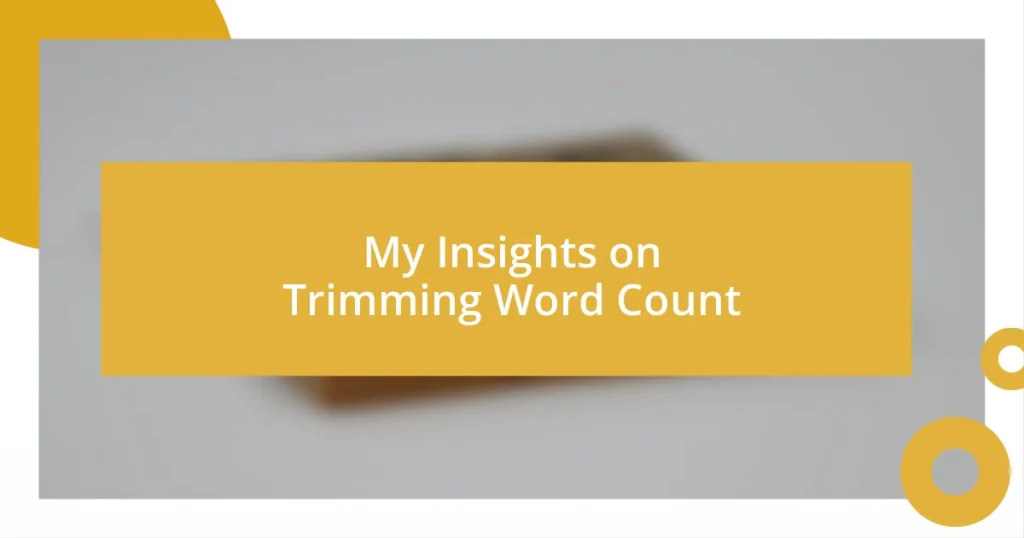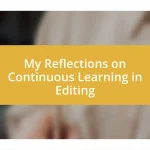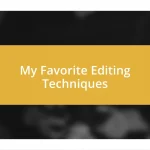Key takeaways:
- Word count is vital for clarity; excessive words can obscure the message, while too few may leave gaps in understanding.
- Identifying redundant phrases and overwhelming length is essential for effective trimming, which enhances engagement and impact.
- Using techniques like active voice, eliminating filler words, and maintaining visual clarity can significantly improve writing effectiveness and reader connection.

Understanding Word Count Importance
Word count plays a crucial role in shaping the effectiveness of any piece of writing. I often find myself reflecting on how every word counts, literally and figuratively. Too many words can muddle your message, while too few might leave your readers wanting more. Have you ever read something that felt overly verbose and lost its essence? I have, and it’s frustrating!
When I was writing my first article, I didn’t realize the significance of brevity. I remember being attached to certain phrases, thinking they added flair. Instead, they cluttered my message and confused my readers. That experience taught me that clear communication is key; the right word count invites engagement rather than overwhelming the audience.
Additionally, understanding word count is vital for meeting platform-specific guidelines. Whether it’s blog posts, essays, or social media updates, different platforms have varying expectations for length. Isn’t it interesting how adapting your writing style to fit these limits can significantly influence audience reception? It’s a skill worth honing for anyone looking to connect effectively with their readers.

Identifying the Need for Trimming
When I sit down to edit my writing, one of the first things I look for is redundancy. It’s amazing how often I find phrases that circle around the same point. I recall a time when I submitted an article that had paragraphs proving my point more than once. The corrections made it much tighter and more effective. Recognizing the need for trimming often starts with a fresh perspective. Sometimes, stepping away from the piece for a bit helps, and when I return, everything seems clearer.
One tell-tale sign that your writing needs trimming is when it feels overwhelming, even to you as the author. I once wrote a report that, upon rereading, felt like a dense jungle of words. Each time I revisited it, I grew more anxious about whether anyone would want to sift through it. I realized that if I struggled to connect with my own writing, my readers likely would too. It highlighted how maintaining clarity and simplicity is essential in connecting with my audience.
It’s not just about word count; it’s about impact. If I look back on my experiences, I see that the most engaging pieces I’ve written are often the shortest ones. A friend once told me that brevity is the soul of wit, and it’s something I strive for every day in my writing. Finding that balance requires practice, but it’s incredibly rewarding. Recognizing when to trim makes all the difference in how your message is received.
| Signs Your Writing Needs Trimming | How to Address It |
|---|---|
| Redundant Phrases | Eliminate repeated ideas and simplify your message. |
| Overwhelming Length | Break up text into shorter sections; prioritize clarity. |
| Lack of Engagement | Focus on impactful language and concise expressions. |

Techniques for Reducing Word Count
When it comes to trimming word count, I’ve discovered that cutting unnecessary adjectives can significantly enhance clarity. I remember a time I wrote a passionate piece that was adorned with colorful language. While I loved the flair, my readers struggled to grasp the main idea amidst all those embellishments. I realized that by stripping away some of those extra words, I could present my thoughts more effectively, urging readers to focus on the core message.
Here are some techniques I’ve found handy for reducing word count:
- Use active voice: It conveys thoughts more directly. Instead of “The ball was thrown by John,” say “John threw the ball.”
- Eliminate filler words: Words like “very,” “really,” and “just” often do little but add length. I’ve learned to be ruthless with these.
- Avoid jargon: Write in a way that anyone can understand. This ensures your message reaches a broader audience.
- Combine sentences: If you find two sentences saying similar things, try merging them into a single concise statement.
- Practice summarizing: Before diving into a longer piece, practice summarizing what you want to say in a single sentence, which helps distill your ideas.
I often revisit those moments when my writing was bogged down by excess words. It’s liberating to see how much more effective a sharp, precise style can be. Trust me; your readers will appreciate the clarity!

Maintaining Clarity While Cutting
Trimming words doesn’t mean sacrificing meaning; it’s about honing your message. I recall editing a lengthy blog post that rambled on for pages. As I cut down to the essentials, I felt a sense of liberation. With each deletion, my point became clearer, and I could see my main argument boldly standing out rather than lost in a sea of words. Isn’t it gratifying when you can strip away the fluff and let your ideas shine?
A key aspect of maintaining clarity during cuts is to focus on your main message. I once faced the challenge of compressing a presentation into a tight time frame. Determined to keep the audience captivated, I centered my points around a single theme, using supporting details sparingly. This approach not only preserved clarity but made the presentation flow seamlessly. Isn’t it amazing how a little focus can lead to a more engaging narrative?
I’ve learned that visual aids can enhance clarity as you trim your text. I remember incorporating graphics in a shorter report to replace long explanations. The images brought my ideas to life and made complex information digestible. When your writing isn’t cluttered, and visuals support your words, don’t you think it captivates readers even more? Clarity thrives when every element, be it words or visuals, works in harmony.

Avoiding Common Trimming Mistakes
One of the biggest pitfalls I’ve encountered while trimming is letting go of essential information. I remember once editing a piece for a client who wanted to cut it down by half. In my eagerness, I pruned too much, and the final draft lost crucial context. It was a painful lesson about the importance of balance. I learned to ask myself, “Does this word or phrase serve a purpose?” before hitting delete.
Another mistake I often see is not considering the audience. During a project, I trimmed down an article that I thought was clear. But a colleague pointed out that the nuances I removed were vital to understanding the topic for our specific readers. This experience taught me to always think about who will be reading my work. Engaging with the audience means making sure vital concepts are intact.
Finally, I’ve found that trimming can sometimes lead to a disjointed flow. There was a time when I cut down a story too aggressively, leaving the transitions awkward. A reader reached out, confused about my logic. Now, I keep an eye on how the sentences connect, ensuring that even in brevity, the writing remains smooth and easy to follow. Isn’t it fascinating how the rhythm of words can impact comprehension?

Revising for Impactful Content
Revising content is where the real magic happens, especially when it comes to impact. I once revisited an article with a heavy emotional theme, and while trimming, I hesitated at a line that encapsulated my feelings beautifully. I finally decided to cut it, thinking it was too flowery. Yet, during feedback, my editor highlighted how that very line connected with readers on a deeper level. This taught me that sometimes, less is more, but the emotional weight shouldn’t be sacrificed. Have you ever leaned into your emotional voice only to worry it might be too much?
As I refined my writing, I learned to look for words that could pack a punch. In one project, I replaced a lengthy description with a single vivid image. Rather than explaining what a sunset looked like, I wrote, “the sky blazed orange.” The response was immediate; readers felt the shift instantly, engaging more with the content. Isn’t it intriguing how the right word can evoke such powerful imagery in just a split second?
Focusing on rhythm also can transform how readers interact with your writing. I remember reworking an impactful statement by varying its sentence length, creating a natural ebb and flow. Some sentences were short and punchy, while others expanded to provide context. This contrast not only kept the reader’s attention but made the overall message resonate more. When you think about it, how often do you pause and breathe while reading? It’s like a dance, isn’t it? Your words should lead with grace and intention.

Final Thoughts on Word Efficiency
When it comes to word efficiency, I’ve often found that less truly can be more. I remember a time when I was tasked with summarizing a lengthy research paper. I hesitated before cutting what I thought were vital sections, but in the end, I discovered that by distilling the core ideas, I clarified them for my readers. Isn’t it wonderful how precision can sharpen understanding?
One thing that strikes me about trimming down text is the power of active voice. I recently rewrote a passage filled with passive constructions, and it transformed the energy of my writing. Suddenly, my message became clear and dynamic, like a conversation rather than a lecture. Have you ever noticed how much more engaging it is to read sentences that jump off the page?
Ultimately, I think it’s essential to balance brevity and clarity. My experience has taught me to regularly revisit the essence of my message and ask, “Does this line advance my point?” Each time I prune closely, I not only refine my piece but also strengthen my connection with the audience. It’s almost like sculpting; the essence of the work truly emerges when you chip away the unnecessary.















